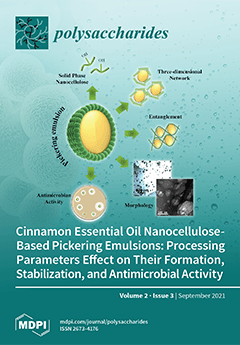Calcium chloride (CaCl
2) has been widely used to maintain the quality of fresh-cut fruits and vegetables because it stabilizes and strengthens the membrane system against fungal attacks. It is mainly applied via spray coating and dip coating techniques. This study explored a method of incorporating calcium chloride extracted from eggshells in a packaging material, thermoplastic starch (TPS), via a hot-melt extrusion process. The composites were characterized by FTIR, DSC, SEM-EDX and tensile testing. FTIR confirmed the chemical reactions between CaCl
2 and TPS. DSC results showed a significant decrease in the heat of fusion by adding 20 wt% of CaCl
2 content in TPS, indicating a drop in the degree of crystallinity. The Young’s modulus of TPS was not significantly affected by the incorporation of 10 wt% CaCl
2 (
P = 0.968), but reduced notably with the addition of 20 wt% CaCl
2 (
P = 0.05), indicating the plasticizer effect of the CaCl
2. Physiochemical analysis of fresh-cut apple slices was assessed. Samples placed on the surface of the TPS/CaCl
2 composites displayed less pH reduction, reduced antioxidant activity, more weight loss and increased reducing sugar compared to the samples placed on the surface of virgin TPS films. CaCl
2 released from the TPS/CaCl
2 films was measured and their antimicrobial activity was confirmed by bacterial inhibitory growth assessment. Fungal growth was observed on apple slices placed on virgin TPS film by day 21 while apple slices placed on TPS/CaCl
2 20 wt% composites did not support any fungal growth for 28 days. In summary, TPS and eggshell-extracted CaCl
2 showed the ability to maintain the quality of fresh-cut apples, and TPS/CaCl
2 10 wt% composite could be a good option as a packaging material for fresh-cut fruits due to active antimicrobial activity and maintained Young’s modulus.
Full article





